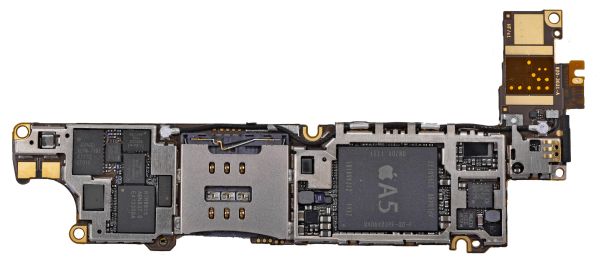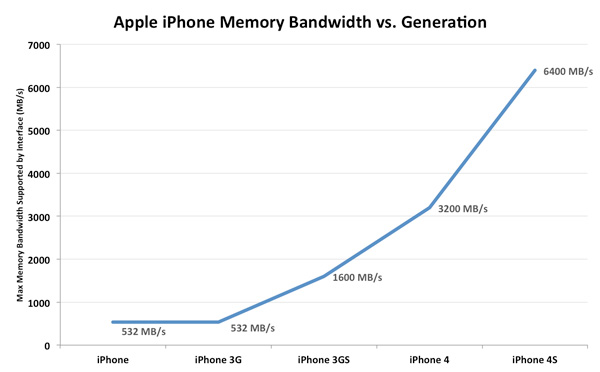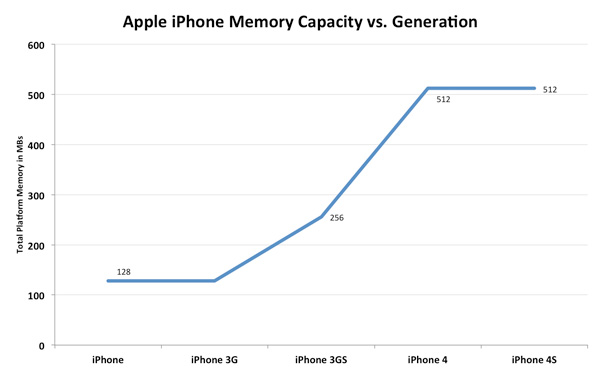Apple iPhone 4S: Thoroughly Reviewed
by Anand Lal Shimpi & Brian Klug on October 31, 2011 7:45 PM EST- Posted in
- Smartphones
- Apple
- Mobile
- iPhone
- iPhone 4S
The Memory Interface
Most SoCs deployed in smartphone designs implement a package-on-package (PoP) stack of DRAM on top of the SoC package. As its name implies, PoP refers to the physical stacking of multiple packages and not layering of raw die. The SoC is typically the lowest level with its memory bus routed to pads on the top of the package. A DRAM package is then stacked on top of the SoC. Avoiding having to route high-speed DRAM lines on the PCB itself not only saves space but it further reduces memory latency.

An example of a PoP stack
The iPhone has always used a PoP configuration for its SoCs and Apple has always been kind enough to silkscreen the part number of the DRAM on the outer package of the SoC. In the past we've seen part numbers from both Samsung and Elpida on Apple SoCs. As both companies can provide similarly spec'd DRAM it makes sense for Apple to source from two suppliers in the event that one is unable to meet demand for a given period.

iPhone 4 mainboard, courtesy iFixit
If we look at iFixit's teardown of the iPhone 4 we see the following DRAM part number: K4X4G643G8-1GC8. Most DRAM vendors do a pretty bad job of providing public data about their part numbers used in chip stacks, so we have to do a little bit of inferring to figure out exactly what Apple used last generation.
The first three characters tell us a bit about the type of DRAM. The K means it's memory, the 4 tells us that it's DRAM and the X tells us that it's mobile DDR (aka LPDDR). The next two characters tell us the density of the DRAM, in this case 4G is translated literally to 4Gbit or 512MB. Characters 6 and 7 are also of importance - they tell us the DRAM organization. Samsung's public documentation only tells us that 16 refers to a 16-bit interface and 32 here would mean a 32-bit interface. Based on that we can safely assume that the 4Gbit DRAM on the A4 is 64-bits wide. In the mobile world a 32-bit interface typically refers to a single channel, which confirms the A4's DRAM interface is two 32-bit channels wide.
The last two characters in the part number, C8, tell us the source clock frequency of the DRAM. Samsung's datasheets tell us that C8 corresponds to a 5ns cycle time with a CAS latency of 3 clocks. Taking the inverse of that gives us 200MHz (frequency = 1 / clock period). Remember, we're talking about double data rate (DDR) SDRAM so data is transferred at both the rising and falling edges of the clock, making the effective data rate 400MHz.
All of this tells us that the iPhone 4's A4 SoC has a 64-bit wide LPDDR1 memory interface with a 400MHz data rate. Multiply all of that out and you get peak theoretical bandwidth of 3.2GB/s. DDR memory interfaces are generally 80% efficient at best so you're looking at a limit of around 2.5GB/s. To put this in perspective, the A4 has as much memory bandwidth as the original AMD Athlon 64 released in 2003.
iPhone 4S mainboard, courtesy iFixit
With the A5 Apple definitely stepped up the memory interface. Once again we turn to iFixit's teardown of the iPhone 4S to lift that oh-so-precious part number: K3PE4E400B-XGC1.
The K once again tells us we're dealing with Samsung memory, while the 3P reveals there are two mobile DDR2 with 4n prefetch (aka LPDDR2-S4) DRAM die on the package. Why not a 4 this time? Technically the 4 refers to a discrete DRAM while the 3 implies a DRAM stack, obviously both are stacked DRAM so I'm not entirely sure why there's a difference here. Each of the next two E4s tell us the density of the two DRAM die. Samsung's public documentation only goes up to E3 which corresponds to a 1Gbit x32 device. Given that we know the A5 has 512MB on-package, E4 likely means 2Gbit x32 (256MB 32-bit). There are two E4 die on package which makes up the 512MB 64-bit DRAM stack.
Once again the final two characters reveal the cycle time of the DRAM: 2.5ns. The inverse of 2.5ns gives us a 400MHz clock frequency, or an 800MHz data rate (source clock frequency is actually 200MHz, but with a 4n prefetch we can transfer at effectively 800MHz). Peak bandwidth to the A5 is roughly double that of the A4: 6.4GB/s. This is as much memory bandwidth as AMD's Athlon 64 platform offered in late 2004, just 7 years later and in a much smaller form factor.
The doubling of memory bandwidth requires a sufficiently large workload to really show it. We see this in Geekbench's memory bandwidth results where the A5 doesn't appear to offer any more bandwidth than the A4 in all but one of the tests:
| Memory Bandwidth Comparison - Geekbench 2 | ||||
| Apple iPhone 4 | Apple iPhone 4S | |||
| Overall Memory Score | 593 | 700 | ||
| Read Sequential | 318.7 MB/s | 302.3 MB/s | ||
| Write Sequential | 704.9 MB/s | 809.2 MB/s | ||
| Stdlib Allocate | 1.55 Mallocs/sec | 1.55 Mallocs/sec | ||
| Stdlib Write | 1.25 GB/s | 2.54 GB/s | ||
| Stdlib Copy | 724.5 MB/s | 490.1 MB/s | ||
| Overall Stream Score | 280 | 281 | ||
| Stream Copy | 413.5 MB/s | 396.4 MB/s | ||
| Stream Scale | 313.3 MB/s | 317.4 MB/s | ||
| Stream Add | 518.0 MB/s | 527.1 MB/s | ||
| Stream Triad | 363.6 MB/s | 373.9 MB/s | ||
Memory bandwidth tests are extremely sensitive to architecture optimizations, particularly for single threaded tests like these so I wouldn't read too much into the cases where you see no gains or a drop.
The increase in raw memory bandwidth makes a lot of sense. Apple doubled the number of CPU cores on the A5, with each one even more bandwidth hungry than the single A4 core. The 4x increase in GPU compute combined with an increase in clock speeds give the A5 another big consumer of bandwidth. Add things like 1080p video capture and the memory bandwidth increase seems justified.
Looking back at the evolution of the iPhone's memory interface gives us an idea of just how quickly this industry has been evolving. Back in 2007 the original iPhone debuted with a 16-bit wide LPDDR-266 memory interface connected to a meager 128MB of DRAM. The 3GS delivered a huge increase in memory bandwidth by doubling the interface width and increasing the data rate to 400MHz. Scaling since then has been even more dramatic:
Memory capacity on the other hand has seen more of a step-function growth:
By using a mobile optimized OS Apple has been able to get around large memory requirements. The growth pattern in memory size partially illustrates the lag between introducing faster hardware and developers building truly demanding applications that require that sort of performance. Apple was able to leave the iPhone 4S at 512MB of RAM because the target for many iOS apps is still the iPhone 3GS generation. Don't be surprised to see a move to 1GB in the next iPhone release (we won't see 768MB due to the dual-channel memory requirement) as the app developer target moves to 512MB.













199 Comments
View All Comments
Pata - Tuesday, November 1, 2011 - link
Will these factors (bluetooth and gps) be incorporated in future tests? I now keep bluetooth and the gps on for Siri and geofenced reminders. I'm guessing that Android phone users might be soon be using bluetooth more often as well, given all the bluetooth watch accessories that will soon be available for their platform. With bluetooth and gps left on, with find my friends, reminders all running in the background, my iPhone usually doesn't last anywhere up to 9 hrs of usage.DukeN - Tuesday, November 1, 2011 - link
Thanks Anand for reviewing every single Apple, iOS, Android/Droid major and minor update since the summer. How about we perhaps devote 2 frickin pages to cover/preview/benchmark some of the newest Blackberry devices?Heck you even covered turds like the HP Veer, and Windows Phone devices.
Perhaps we can devote a couple of pages to the smartphones that have a quarter of the market?
Thanks
jamyryals - Tuesday, November 1, 2011 - link
Even as a [forced] Blackberry user, I'd rather they didn't spend their time reviewing Blackberry devices.Also, it is "biased" in that case.
SicMX - Tuesday, November 1, 2011 - link
Fantastic review, keep up the good work!PS. Especially appreciated the in-depth review regarding the camera + image quality.
Matt Campbell - Tuesday, November 1, 2011 - link
Nice article Brian, Anand. One clarification for Page 8, Siri can't read emails - only incoming (new) text messages. She'll tell you this herself if you ask her to read your emails :)And one comment, the addition of Bluetooth 4.0 is a big leap forward in my opinion. The Bluetooth stack in every other iPhone revision was missing the Serial Port Profile stack, which severely limited hardware developers. Since the 4S is "Bluetooth Smart Ready", it should support all kinds of fun new sensors and gadgets without the need for additional hardware.
_tangent - Tuesday, November 1, 2011 - link
Great in depth review! Anandtech is one of the only places you can find this sort of analysis, and for the technically minded consumer, it's an invaluable resource. Kudos!I'm a bit confused by the GPU arms race in the mobile space. Aren't we reaching a point where the screen is small enough and far enough away from your face that the law of diminishing returns applies? Unless the ultimate objective is to have us all connect our phones to tvs or other displays for gaming on a larger scale.
I'm not sure where i stand on mobile gaming these days. I have a relatively capable android handset, but find myself not even playing the 3D games already available. Not because they aren't good or pretty enough, just because intensive 3d gaming slams my battery, is less well suited to the odd 5 minute opportunity i get to game on the go, and the lack of physical controls for more "conventional" games is often frustrating. In any case, having lived with the handset for 6 months or so, i'm not clamoring for better 3D performance. Maybe plenty of people are though.
I'm not personally a fan of Apple products. Not because they don't offer a great UX and aren't well polished in their own right, but because the cost apparently associated with that is too high. As a software developer by trade I find their draconian, fascist approach to the appstore and development in general somewhat distasteful. I don't equate choice and flexibility with complexity. That said, i don't mind Apple in a world where they have competitors offering an alternative philosophy This drives everyone to innovate which is great for us as consumers.
Hopefully ICS will bring Android up to par with iOS from a UX point of view, whilst retaining the flexibility and customization that much of it's user base has come to appreciate. I look forward to a similarly comprehensive look at the Galaxy Nexus and other ICS phones as they're released!
Shinobi123 - Tuesday, November 1, 2011 - link
Why is the New Razr missing from most of the graphs? It was in the first few, basically the only reason I kept reading this article.. But it wasn't included in any. :(tipoo - Tuesday, November 1, 2011 - link
They probably aren't done testing it.rimshaker - Tuesday, November 1, 2011 - link
As usual, the very best in depth product review available. As a EE, no review is ever thoroughly complete until I read it here on Anandtech. Wonderful!My only question is how to display the numerical wifi RSSI without using 3rd party apps? I tried it in field test mode but the wifi icon never changes like the cell signal does.
dubthedankest - Tuesday, November 1, 2011 - link
I second this question as well as the one prior on how to enable the numerical RSSI for WiFi - that would be very helpful.Great review!